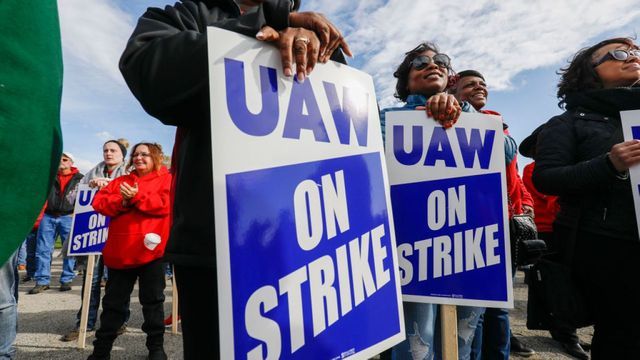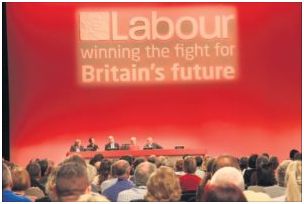Steve Edwards is a member of Socialist Alternative in the US.

On September 16, 49,000 UAW members walked off the job at all 55 GM manufacturing plants and parts centers in the U.S., in what became the longest national auto strike in half a century. The determination shown by auto-workers on this strike was exemplary. Some remortgaged their homes to make it through the month without pay and picket lines were rock solid throughout. Striking workers constantly spoke of their sense of solidarity in prioritizing ending the use of temporary workers, to hire them on with full benefits and to reduce the number of tiers going forward.
Workers have voted by 57% to approve a contract which, while it contains some gains but is far from fully meeting the key goals expressed by strikers Socialist Alternative has spoken to. Most important, the contract contains a path for temporary workers to become permanent and for everyone below the “legacy” Tier 1 workers to ultimately achieve parity on pay, although not on pensions and other benefits. However, the path for temporary workers is far too long and if it wasn’t for the lack of a clear strategy from the leadership for how to fully win this demand, the contract would have likely been voted down. An opportunity has been missed to strike the biggest blow yet for working people in the strike wave that began with teachers began in West Virginia.
The economic impact of the strike threatened some GM parts suppliers with bankruptcy and 12,000 of their employees were laid off. GM lost over $3 billion in revenue, while investor losses run far higher. Rating agencies considered downgrading GM stock to junk status. The strike was overshadowed by the looming probability of a recession, and by the rejection of the Chrysler contract in 2015 by a two to one margin, a loss that the UAW leadership did not wish to repeat.
What drove this strike was the pent up fury of workers across the country, but especially in the auto industry, at companies like GM which have continued to hold down wages and attack job security, working conditions and benefits while flaunting massive profits for shareholders. GM in particular paid its CEO $22 million last year on the backs of workers who are unable to hold their lives together, many making borderline poverty wages with the massive insecurity of being classed as temporary or outsourced contract employees. This is the same fury which is fueling support for Bernie Sanders’ inspiring calls for a world in which billionaires will be abolished and in which medical care will be free for all. It is an indication of this wider mood that at around the same time as the strike was nearing its end, Sanders’ question, “Are you willing to fight for that person who you don’t even know, as much as you’re willing to fight for yourself?” went viral.
Anger against the super-rich has been building since 2008, and the mass appeal of Bernie Sanders’ campaign for Medicare For All became a factor in union negotiations. GM, which initially withdrew employees’ medical benefits within days of the strike’s beginning, experienced a massive backlash and were forced not only to reinstate them but to agree to freeze medical costs for the life of the contract. This is a major win for auto workers, and an indication of the pressure of the movement for free and universal health care.
The strike was solid, with no reports of members crossing the picket lines, and there was clearly a strong groundswell of working class support, with other unions, neighbors and family members turning out on picket lines – including, critically, Ford and Fiat-Chrysler workers who know that the pattern set at GM will set the stage for their own contracts.
Union veterans were deeply moved by the level of community support. For example, at the Wyoming, Michigan axle plant near Grand Rapids: “I’m actually overwhelmed by the support of the community,” said Willie Holmes, President of UAW Local 167. “They have just been stepping up left and right like you would not believe. I mean, every time I blink, here comes another truckload of food. Or just, somebody wants to come in and just donate their time.”
“I’ve never seen so much support in all my life as this one here,” says Mike Mieras, a retiree from UAW Local 167 who says he went through many strikes in his career. “It’s really changing the subject in this country, where we hope that everybody else makes a good fair wage no matter whether they’re union or non-union.”
Many strikers were the children and grand-children of “legacy” Tier 1 GM workers, who are keenly aware of the massive disparities in pay created by the multi-tier pay scales which were accepted by the UAW in the past, under the wrong idea that these were temporary measures to save the company from bankruptcy. The worst of these concessionary contracts was signed in 2007 – a year before the financial crisis – and workers on the picket line expressed again and again their sense of betrayal, that these concessions were supposed to be temporary but that in the years since then, GM has not only maintained but has actually expanded the use of temporary workers.
These past concessions mean that there are today eight categories of employees in GM factories, including hundreds employed by the notoriously anti-union labor agency Aramark, doing both janitorial and skilled trades work such as carpenters and electricians.
At least 7% of GM workers are currently “permatemps” making around $15 an hour with very limited benefits. These workers can be fired for as little as two minor work rule infractions so have no job security. They accrue no vacations or seniority, are only allowed three unpaid days off per year with advance approval and can be made to work seven-day weeks. They can be fired for not turning up for work in a family emergency and they can remain temporary for years. A disproportionate number of these workers are women.
These were the workers this fight was about. During the course of the strike, some workers re-mortgaged their homes rather than back down and communities rallied to support them. As the contract was being voted on, Socialist Alternative members went to Detroit-Hamtramck and interviewed Larry Jones, a 44-year GM veteran and therefore a Tier 1 worker. Larry gestured towards a fellow striker and said “This wasn’t my fight, this wasn’t his fight, we are doing this for the next generation, we did this for the temps coming up behind us. This shows the rest of the country what collective bargaining can do…People did this before me, and if and when the day comes, he will do it too.”
The Complicated Influence of UAW National Leadership
UAW leadership, having called no comparable strikes in many years, launched this national action abruptly, with no pre-strike rallies or training exercises. There was no national campaign to bring the struggle to other sections of the working class, unfortunately in some cases community supporters were sent away from the picket lines on orders from Solidarity House, and the UAW leadership was so concerned to control the messaging that they even discouraged their own members from carrying home-made picket signs.
The leadership is also dealing with a growing corruption scandal involving union officials stealing funds from worker training programs. Numerous union leaders and at least one company executive have been jailed, and recently the homes of top leaders of the union have been searched by the FBI. They rightly feared that if they did not deliver on the key issue of creating a path from temp to permanent status, they could be swept from office for the first time since the Reuther leadership cemented its hold in the 1930’s.
On Oct 13, in response to an insulting and ill-advised letter from GM directly to each employee, pleading them to tell their union to end the strike, the UAW announced that it was planning to start picketing GM dealers. Although this threat was never carried out, this was the point at which the company became willing to bargain over the key issue of bringing the temps into permanent status and a TA (Tentative Agreement) was announced days later. This is the agreement that the membership have now voted on.
The New Contract
In addition to the freeze on health care cost increases this contract includes, for the first time since 2007, a path for temporary workers to become permanent, beginning with those who already have three years’ uninterrupted service as temps; this period will be shortened to two years beginning on January 1, 2021. A serious weakness in this language is that “uninterrupted” means with no layoffs of more than 30 days, and in the auto industry such layoffs are common, so in theory, GM could undermine this deal through the use of 31 day layoffs; while there is other language governing layoffs this is an indication of the fights that lay ahead in order to defend this gain.
Other gains include a path to pay equity for Tier 2 workers, who will be able to reach the top pay of legacy GM workers, still far from highly paid at $32.32, after four years rather than the present eight. But the bigger difference between legacy, or Tier 1 workers and the rest is their defined-benefit pension plan and retiree health care. Neither of these will be added for the Tier 2 workers. This is a concession that should never have been made and many workers are pointing out that in the past, every worker was raised to the same pay and benefit levels after only 90 days. This puts these relative wins in perspective.
Signing bonuses, ranging from $11,000 down to $4,500 for temps will roughly compensate for pay lost during the strike. But temps, who get a small bump in pay to $16.6, pennies more than half the top rate, will not see any more raises as long as they remain in temp status.
Losses include the union giving up its lawsuits against GM’s closure, almost one year ago, of three-out-of-four factories, which include Lordstown, Ohio in violation of their previous agreement; no increases in retiree pensions, which have not been raised in 12 years; and no real assurance that the company will not continue to move jobs offshore, or, as with its proposed major moves into electric vehicles, that it will employ UAW members to make them rather than setting up shell “startup” companies from which it will then buy these vehicles.
Workers at GM’s twenty component plants and parts warehouses won the least out of this contract and voted by wide margins against it. Their wages are already on tiers well below Tiers 1 and 2, and their wages will continue not to top out for eight years – at $25 or less depending on where they work.
Far more could have been won. But this would have required a leadership worthy of the courage and self sacrifice shown by the rank and file. That determination is clearly evidenced by the fact that for 40 days there was effectively no scabbing, and the public support has been widely acknowledged.
Many workers, and especially those at the now-doomed plant in Lordstown, Ohio where the “no” vote was over 80%, feel deeply disappointed and in some cases, downright betrayed. As one striker eloquently stated: “I thought this strike was going to be revolutionary, a history-maker, because that’s the feeling I had when we walked out. I thought America was due for a revolution and our strike was going to be it.”
A union leadership that was paying attention to the changes in society – for example, last year saw a thirty-hear high in days lost to strikes, a process led by the teachers’ strikes that clearly went far beyond basic trade union demands for better pay and benefits – would have gone to the public just as the Teamsters did under the leadership of Ron Carey in 1997 with the slogan “Part Time America Won’t Work.” This slogan was aimed at every worker, and especially youth, looking for a decent life. It pointed away from the gig economy towards a world of full time employment and a family-supporting wage. To build that campaign, union members were hired a year in advance of the contract’s expiration, both to organize the workforce and for public outreach.
Today, quite unlike in 1997, there is an openness to Socialist ideas and a wide understanding, as we’ve seen in the youth climate strikes, that things cannot go on as they are. The UAW missed a gigantic opportunity to highlight the things that many workers already generally understand, which is that good union wages raise pay standards for all workers, and also to press the auto industry to invest in good jobs building green technology.
But this leadership failed to do even the most basic things that are commonplace when preparing for a strike. As experienced organizers at Labor Notes have pointed out, “The strike jumped off when dealers’ lots were full, and customers did not feel the impact… Members role was limited to picketing and volunteering for duties such as snack delivery. Before the strike, officials made no attempt to involve members in a contract campaign. Not a button was distributed in the plants. There was no survey of the membership, no contract action teams, no turn-down of overtime – some plants building popular models worked scads of overtime right up to the bell – no outreach to the public, no open bargaining.”
Media reports and our own discussions on the picket line have underlined that the vote to accept the contract was largely based in a sense of inevitability. This sense came from the union leaders’ passivity and failure to develop the campaigns they could have launched.
But older workers also conveyed the sense that a younger generation will have to take up where they left off and they are justly proud of a win that in principle will allow temps to graduate to full time status. In the coming months these younger workers will have to defend those gains and the local leaders who stepped up to keep this strike going will look to develop an effective, combative union going forward. The UAW has a fighting history and still retains democratic structures which will allow these workers to begin to forge a new fighting leadership for their union. A fighting union with more victories under its belt would be far more attractive to workers in the unorganized foreign-label factories, making disasters like the recent VW and Nissan votes less likely to be repeated.



